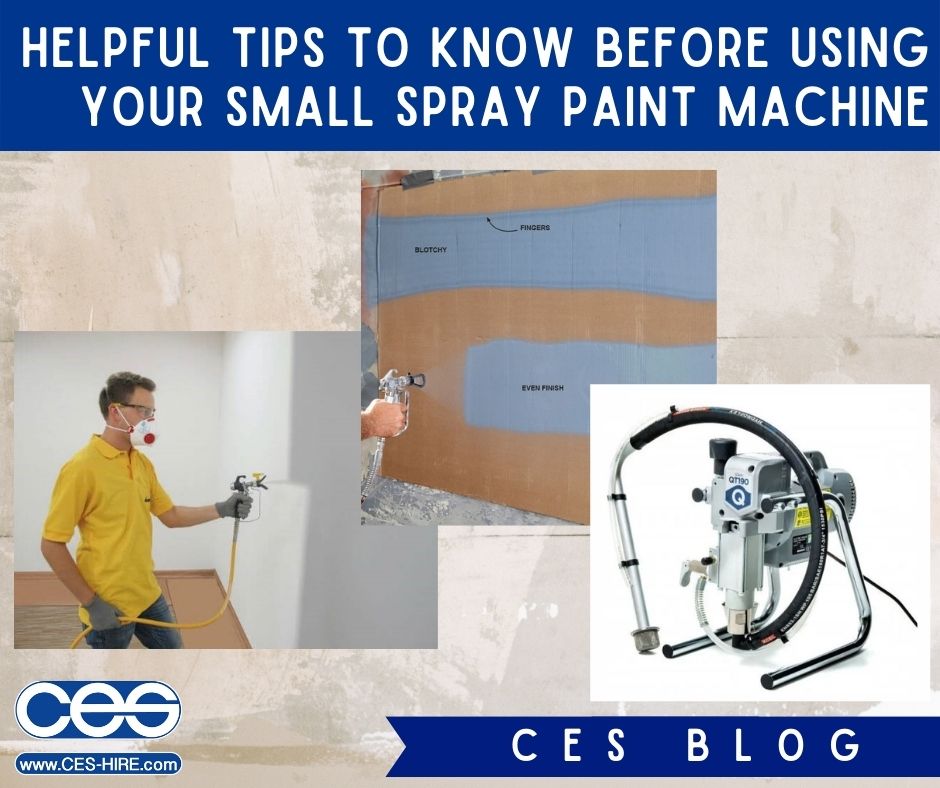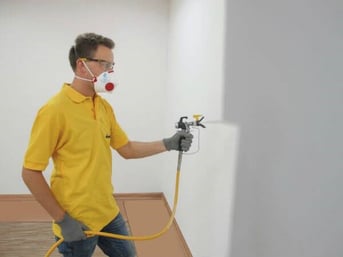Paint Spray Machines
Helpful Tips To Know Before Using Your Small Spray Paint Machine
Before You Go In All Guns Blazing...
Whether it be customer demands or nags from the wife, we all want to get that paint job done and done quickly. Speed is one of the main draws when it comes to using a small spray paint machine but as always there is preparation to be done before you go in all guns blazing (if you pardon the pun!). Preparation is often deemed as the boring part; however, it is essential and actually leads to a speedier job overall. So, check out the following tips before getting started with your spray paint machine and you'll achieve that perfect paint finish in no time.
PPE Is Key
We're all used to life with masks now thanks to Covid. However, masking up is extremely important when it comes to using your paint spray gun machine since you don't want to inhale toxic fumes and overspray. As well as wearing a mask ensure you ventilate the room well and take regular breaks since paint fumes can cause light-headedness and dizzy spells.
It is a legal requirement to wear PPE when spray painting. CES would recommend wearing a respiratory mask, gloves and safety goggles as well as long sleeved clothing and proper work boots for further protection. It is also crucial never to point the spray gun at anyone and take care to point it away from yourself. With a spray gun pushing out over 3000PSI that can cause serious injury as it acts just like a needle puncturing the skin. You must immediately go to hospital if this happens since paint injected into the body can be fatal. All machines are supplied with a tip guard and we recommend using this to prevent injury. Please ensure your fingers or any other body parts are never in front of the spray jet.
Mask Up
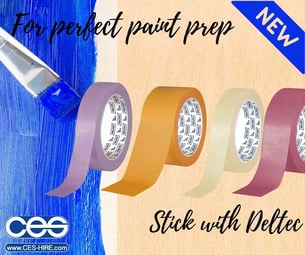 Not only is a respiratory mask important but masking up with the tape variety is also key for a smoother process and faster finish. Cover up anything you don't want to get paint on; this is where pre-masked drop film and carpet protection really comes in handy for quick preparation. Don't forget CES also stock a range of painters tape that are ideal to use for painting projects as they ensure crisp lines and clean, no-residue removal. In terms of preparation, some paint jobs may require a primer, especially if you are painting over a darker colour with a light one.
Not only is a respiratory mask important but masking up with the tape variety is also key for a smoother process and faster finish. Cover up anything you don't want to get paint on; this is where pre-masked drop film and carpet protection really comes in handy for quick preparation. Don't forget CES also stock a range of painters tape that are ideal to use for painting projects as they ensure crisp lines and clean, no-residue removal. In terms of preparation, some paint jobs may require a primer, especially if you are painting over a darker colour with a light one.
Triple Filtering
Choosing the correct tip and filter size for your airless spray-painting machine is important to ensure the best professional finish. When it comes to the filter, remember the more viscous the material, the coarser the filter should be. Check out CES's spray tips and spare parts here.
There are three filters to bear in mind with CES’s QTech range of Airless sprayers. These are:
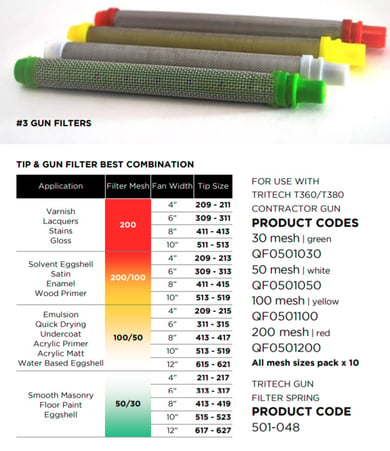
- Suction Filters-Filters the paint at the source
- Manifold Filters- Filters the paint in the machine
- Gun/Pencil filters- Filters the paint in the gun
This triple filtering ensures the smoothest paint for an exceptional finish and reduces the need for multiple coats whilst also preventing blockages in your spray gun. Essentially the largest particles of un-sprayable fragments are filtered first using the most open mesh filters, the mesh size gradually reduces so that upon the final filter the smallest particles are removed to leave the best quality smooth paint. The Suction and Manifold filters are generally a standard for specific machines however the gun/pencil filters will vary according to the type of paint and therefore spray tip you have selected. Take a look at the chart to determine the correct gun filter and spray tip for you.
Tip-top Painting
Your material is the starting point for determining the spray-tip size; the thicker the paint, the wider the diameter of the nozzle. The nozzle size will inform you of the width of the spray jet. The bore diameter of a nozzle controls the flow rate.
If you don’t know which tip you need, we recommend looking at the paint product data sheet. These can often be found on the paint manufacturers website. Usually you can find the ‘Recommended Orifice Size’ in the ‘Application Methods’ section of the specification data sheet. Read more about selecting the right tip size here >
For example, Dulux Diamond Matt. If you look at the ‘Spray Recommendation’ area, you can see the recommend tip orifice size is 15 thou. This means you need to select a tip with a 3 digit index that ends with ’15’ – Eg, 315, 515, 715 .etc.
Practise Makes Perfect
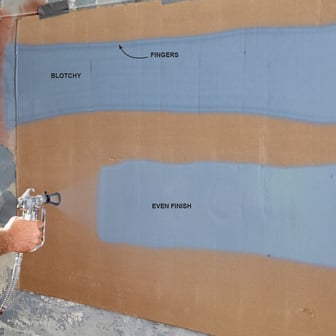 Paint Spray machines used to be designed for the professional only and machines would cost you a pretty penny. However, the cost of such machines have drastically reduced and machines are much more accessible for the amateur/DIY-er but the key is to practise. If you are less experienced with using a hand paint spray machine, it is imperative to practise. Start in a large flat area that is perhaps not the most visible wall. Spray with water to begin with to get the hang of the machine (always ensure the water has dried out before applying paint). Use scraps of card to practise with paint and perfect your spray pattern. You’re looking for a consistent spray pattern with no tailing. Tailing is when two distinctive lines appear on the edge of your spray pattern which leads to stripy-looking paint. The edges of your paint should be soft to seamlessly blend between one pass and another. If you are experiencing tailing during your practise check these three elements:
Paint Spray machines used to be designed for the professional only and machines would cost you a pretty penny. However, the cost of such machines have drastically reduced and machines are much more accessible for the amateur/DIY-er but the key is to practise. If you are less experienced with using a hand paint spray machine, it is imperative to practise. Start in a large flat area that is perhaps not the most visible wall. Spray with water to begin with to get the hang of the machine (always ensure the water has dried out before applying paint). Use scraps of card to practise with paint and perfect your spray pattern. You’re looking for a consistent spray pattern with no tailing. Tailing is when two distinctive lines appear on the edge of your spray pattern which leads to stripy-looking paint. The edges of your paint should be soft to seamlessly blend between one pass and another. If you are experiencing tailing during your practise check these three elements:
- Check the pressure setting and increase the pressure to supply the gun with more paint.
- Dilute the paint. Viscosity is crucial for effective paint spraying.
- Inspect the spray tip and nozzle size looking for wear and tear that may mean it needs replacing (read more about tip maintenance here >)
Plan your Project
Before using your airless paint sprayer it is important to consider your project to ensure you are using the correct machine for the demands of your job. Think about the following questions:
- Are you painting a whole house or just a single room?
- Do you have a vast area to cover or is your job more detail focused?
- What sort of surface are you covering? (plastered walls/skirting boards/doors)
- Are all the areas accessible or do you need additional tools to help e.g. a tip extension for your spray gun or ladders/scaffold?
- Do you need to cover flooring/furniture/windows/doors?
- Do you need to mask off areas?
- Is your paint the correct viscosity?
- What Spray tip and filter do you need?
- Do you have the correct PPE?

